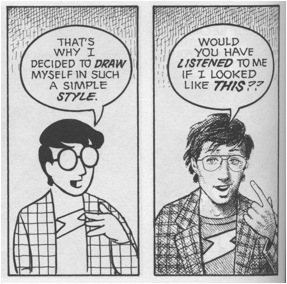Quantum and Woody was something I loved when I was a teenager -- and then it went away. 13 years later it shows back up, but under less than ideal circumstances. It's not the book I remember, and I don't know if I should be happy it's back or pissed about it being something less than what I expected and hoped for.
Even if you've never read a Quantum and Woody comic before, I'm guessing that the previous paragraph was suitably unsubtle that you realized it was a metaphor for the plot of the comic.
I posted about the status of Quantum and Woody previously. The gist: the original comic was published by Acclaim, and the creators, Christopher Priest and Mark Bright, had a reversion clause in their contract that should have allowed them to buy out the copyrights to the comic after it went out of print. But Acclaim went bankrupt and the rights were sold at auction instead. They were eventually bought by a new company, Valiant (which takes its name from the Valiant Comics that Acclaim bought out in the first place, but is not the same company), which has opted to start a new series written by James Asmus and drawn by Tom Fowler.
Priest has said nothing about the new series, and Bright has said little -- but he did say that their relationship with Valiant is "amicable", and that was good enough for me to go ahead and pick up issue #1 of the new series.
It's...well, it's good, but it's not as good as the original.
First of all: it's not very funny.
I mean, I laughed a few times. But the biggest laugh was at a running gag from the old series. Technically it still counts as a joke -- they're invoking a running gag, not merely doing a Family Guy-style "Hey, remember that thing from that other thing?" -- but it's not Asmus and Fowler's joke, it's Priest and Bright's.
And the whole thing feels a little like that, really. The book doesn't just borrow the premise of the original, it borrows Priest's specific storytelling techniques -- it's got chapter titles with white text against a black background, and it jumps around and tells the story out-of-sequence. Yes, that's one of the things the original Q&W was known for -- but it wasn't a Q&W thing, it was a Priest thing. He used the same technique in Black Panther and Deadpool. For my tastes, this strays a little too far from the notion of a loving homage to the original series and too close to stealing another guy's bit. It's uncomfortable.
And it's also absurd, given that Valiant chose not to ask Priest and Bright to do the new series themselves, ostensibly because they wanted to do something different, that the new book hews so close to the old one stylistically.
And yet, for all that, page 2 passes up a perfect opportunity to use "noogie". What the F-word? I just don't understand how Asmus can crib so shamelessly from the original series (and Priest's general comics vocabulary) and yet draw the line at noogie, of all places.
...okay, that got a little inside baseball. Point is, the book, at its worst, feels like a cover tune that's uncomfortably close to the original without ever hitting the same notes quite right.
But at its best?
It's got heart, man.
Asmus may not have a good grip on Priest's gift for satire -- and couldn't get away with his brand of pointed commentary on race in America even if he did -- but what he does get is the relationship between the leads. It's real and it's raw -- these are two guys who really do love each other (but they're not a couple) but are so fucking furious at each other over something that happened a long time ago that it takes a near-death experience to even acknowledge it -- almost.
Asmus gets that. And it just so happens to be the emotional core of the book. More important than the jokes, and certainly more important than "Hey look you guys we put the goat on the cover!" -- it's the heart.
Aside from that, the plot actually hews pretty close to the original, despite an important change in apostrophe placement -- now, Eric and Woody are reunited after their father's murder, not fathers'.
That's been the change fans of the old series have been most nervous about -- well, the story change that fans of the old series have been most nervous about. But it works.
Ultimately, Eric and Woody's fathers weren't important to the original story; they were the McGuffin that got everything started, but we knew less about them than we knew about Uncle Ben (and only slightly more than we knew about Thomas and Martha Wayne in the original version of Batman's origin). Woody's father is only important because he's what got him to come back to town -- it's his mother who we see is mostly responsible for what shaped him as a child, for better or worse.
And all that would seem to be intact -- in this version, Eric's father took Woody in as a troubled foster child. And, while the circumstances of Woody's departure from the family are left as a mystery for now, I wouldn't be surprised if they were similar to what happened in the original series: he went to live with his mom, things went south fast, and he wound up living on the streets.
All of which is still entirely possible if Mr. Henderson was his adoptive father. Mr. Van Chelton is completely unnecessary to the story.
Through all this chatter, I guess I've focused on Asmus's writing over Fowler's art. Fowler's art is like Asmus's writing, I suppose -- it's solid but it hasn't blown me away, and unfortunately a whole lot of it seems to be just recreations of scenes from the original series (like the opening of Q&W falling out a window while the news media mock them).
Still -- it's good. It's not what I'd hoped for, but it's not bad.
It's good enough that I'll pick up #2. And hope that this generates enough interest that maybe someday we'll see something new from Priest and Bright. New Quantum and Woody, the release of the completed-but-unpublished issues of the original series, or something else entirely -- it doesn't matter, I'd be happy to see anything by them that I haven't seen before.
Because that's the real point, here -- yeah, I like Quantum and Woody. But not nearly as much as I like Christopher Priest and Mark Bright.




